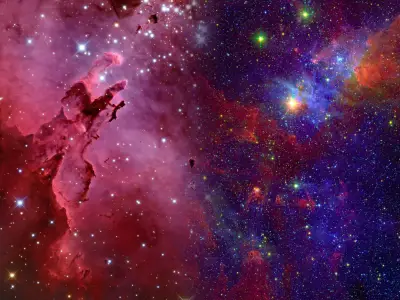Among the lesser-known constellations, Indus holds its own quiet charm. Whether you're a seasoned stargazer or simply curious about the stars, learning about the Indus constellation opens a new window into the southern hemisphere’s sky. This guide will explore the history, mythology, and characteristics of Indus, as well as how you can spot this fascinating constellation in the night sky.
Jump to:
Recommended for you!
Best SellersWhat is the Indus Constellation?
Indus is a constellation located in the southern hemisphere. It’s not the brightest or most famous constellation, which may be why many people know little about it. However, it plays an essential role in mapping the night sky for astronomers, particularly in the southern hemisphere.
The constellation was first catalogued by Dutch astronomers Petrus Plancius and Jodocus Hondius in the late 16th century, based on observations made by explorers Pieter Dirkszoon Keyser and Frederick de Houtman during their voyages to the East Indies. The constellation symbolises a representation of a native Indian, though it does not refer to any specific mythological figure. Instead, it reflects the European fascination with exotic lands during the Age of Exploration.
What Does Indus Look Like?

How Big is Indus?
The size of Indus in the sky is quite significant, covering an area of 294 square degrees, making it the 49th largest constellation. It sits between the constellations Grus, Tucana, and Pavo, and is bordered by other faint southern constellations.
Despite its relatively large area, its faint stars make it easy to overlook, especially in areas with a lot of light pollution. This is one of the reasons why Indus is lesser known and why we know so little about Indus compared to more prominent constellations.
The Indus Constellation Myth

Unlike constellations with well-established Greek myths, Indus doesn’t have an ancient story attached to it. Instead, it was created during a time of European exploration, when constellations were named after figures or concepts unfamiliar to European audiences. Indus represents the idea of a ‘native’ person of the East Indies or other far-flung places that European explorers encountered during their travels.
What is the Meaning of the Word Indus?
The word ‘Indus’ itself originates from Latin, referring to India or a person from India, but the constellation does not correspond to any particular Indian mythology. It’s more of a symbolic representation of the concept of ‘the Indian’ or native peoples as seen by the European explorers during the Age of Discovery. This explains why Indus lacks the rich mythology or symbolic depth found in many other constellations.
Indus' Stars

The Indus constellation contains several intriguing stars, each contributing to its distinctive triangular shape:
- Alpha Indi: The brightest star in the Indus constellation, Alpha Indi is an orange giant located approximately 101 light-years from Earth. It stands out as the most prominent star in this constellation, though it’s still relatively faint compared to stars in other constellations.
- Other Stars: While not as bright as Alpha Indi, stars like Beta Indi and Delta Indi help define the structure of Indus. Though these stars may not be well-known on their own, they play a vital role in shaping the constellation and its visibility in the night sky.
Finding Indus in the Sky
Indus is best viewed from the Southern Hemisphere, particularly during the spring and summer months, with optimal viewing times in September, October, and November. Since the constellation isn’t visible from northern latitudes, those near the equator or further south will have the best chance of spotting it.
Locating Indus
To find Indus, you’ll need to look for nearby, brighter constellations to guide you. Indus is situated between the constellations Grus, Pavo, and Tucana. While its stars are relatively faint, starting with these brighter constellations can help you locate it more easily. Clear skies and minimal light pollution are essential due to the faintness of Indus' stars.
Viewing Indus with Binoculars or a Telescope
- With Binoculars: The faint stars of Indus may be difficult to spot with the naked eye, but binoculars can help you pick out its main features more clearly.
- With a Telescope: For a more detailed look, a telescope can enhance your view of Indus, allowing you to explore the faint stars and any deep-sky objects nearby.
The Best Viewing Conditions
For the best chance of seeing Indus, try to observe from a location with dark skies, far from city lights. A clear, moonless night will make the faint stars of this constellation more visible. If you’re in the Southern Hemisphere, the months of September to November offer the best conditions for spotting Indus.
Recommended for you!
Best SellersFun Facts About Indus
- Faint Stars: Despite its size, Indus is a relatively faint constellation, which is why it often goes unnoticed.
- Southern Hemisphere: Indus is best observed from southern latitudes, and cannot be seen from northern regions.
- Orange Giant: Alpha Indi, the brightest star in the constellation, is an orange giant star about 101 light-years from Earth.
- No Major Nebulae: Unlike other constellations, Indus is not home to any famous nebulae or star clusters that can easily be seen with the naked eye.
Study Astronomy for £29
The Indus constellation is a stunning and significant part of the night sky, offering beauty and rich history. If you're inspired to delve deeper into the wonders of astronomy, why not explore the Astronomy Diploma Course with Centre of Excellence? Whether you're a beginner or someone with more experience, this course will guide you through everything you need to know about the stars, constellations, and galaxies. And for a limited time, you can enrol for just £29!













